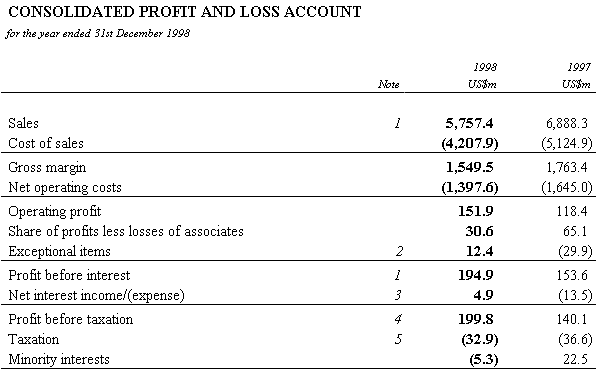
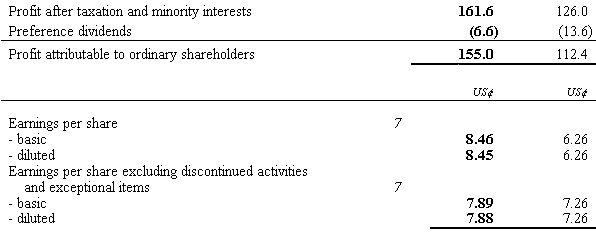
DAIRY FARM INTERNATIONAL HOLDINGS LIMITED
PRELIMINARY FINANCIAL STATEMENTS
FOR THE YEAR ENDED 31ST DECEMBER 1998


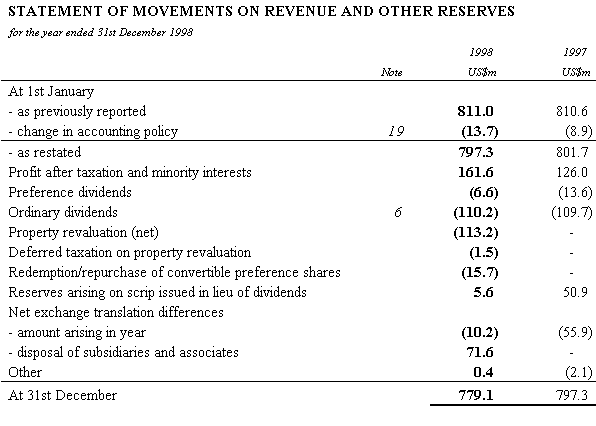
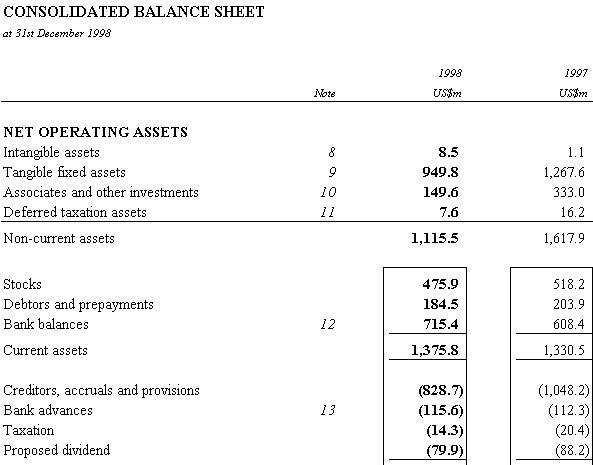
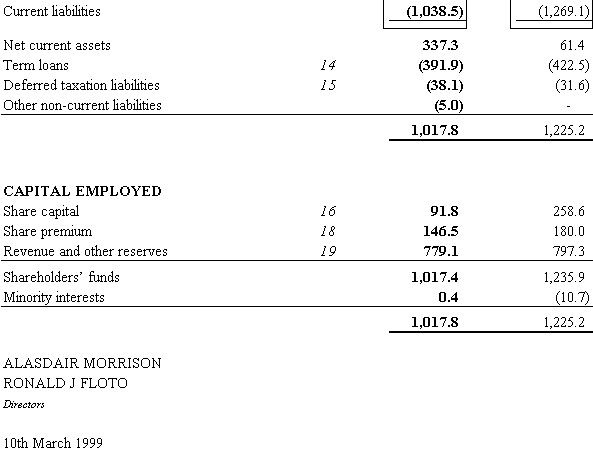
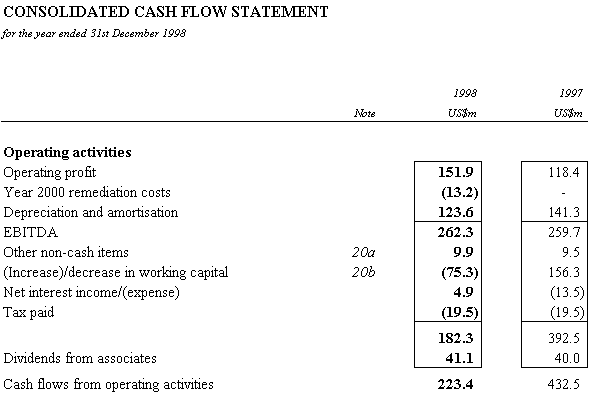
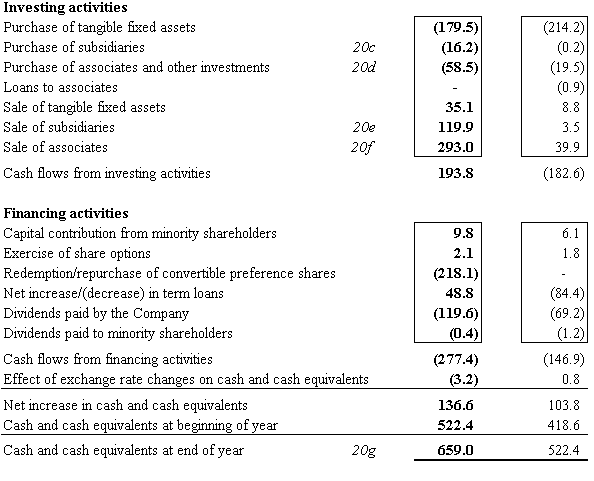
PRINCIPAL ACCOUNTING POLICIES
A. Basis of preparation
The Financial Statements have been prepared under the historical cost convention, as modified by the revaluation of certain non-current assets, and in conformity with International Accounting Standards.
B. Basis of consolidation
(i) The consolidated profit and loss account and balance sheet include the financial statements of the Company, its subsidiaries and, on the basis set out in (ii) below, its associates. The results of subsidiaries and associates are included or excluded from their effective dates of acquisition or disposal respectively, and are based on their latest audited financial statements which are made up to 31st December 1998.
(ii) Associates are companies, not being subsidiaries, in which the Group exercises significant influence and has an attributable interest of 20% or more of the ordinary share capital held for the long term. Associates are included on the equity basis of accounting.
C. Foreign currencies
Assets and liabilities of subsidiaries and associates, together with all other monetary assets and liabilities expressed in foreign currencies are translated into United States Dollars at the rates of exchange ruling at the year end. Results expressed in foreign currencies are translated into United States Dollars at the average rates of exchange ruling during the year.
Net exchange differences arising from the translation of the financial statements of subsidiaries and associates expressed in foreign currencies, and exchange differences on transactions which hedge these investments are taken directly to exchange reserves. On the disposal of these investments, such exchange differences are recognised in the consolidated profit and loss account. All other exchange differences are dealt with in the consolidated profit and loss account.
D. Goodwill
Goodwill represents the difference between the cost of an acquisition and the fair value of the Groupís share of the net assets of the acquired subsidiary or associate at the date of acquisition. Goodwill on acquisitions occurring on or after 1st January 1995 is reported in the balance sheet as an intangible asset or included within associates, as appropriate, and is amortised using the straight line method over its estimated useful life which is generally between 5 and 20 years. Goodwill on acquisitions which occurred prior to 1st January 1995 was taken directly to reserves.
The profit or loss on disposal of subsidiaries and associates is calculated by reference to the net assets at the date of disposal including the attributable amount of goodwill which remains unamortised but does not include any attributable goodwill previously eliminated against reserves.
E. Tangible fixed assets and depreciation
Land and buildings are stated at valuation. Independent valuations are performed every three years on an open market for existing use basis. In the intervening years the Directors review the carrying value of land and buildings and adjustment is made where there has been a material change. Revaluation surpluses and deficits are dealt with in capital reserves except for movements on individual properties below depreciated cost which are dealt with in the profit and loss account. Other tangible fixed assets are stated at cost less amounts provided for depreciation.
Depreciation is calculated on the straight line basis at annual rates estimated to write off the cost or valuation of each asset over its estimated useful life.
The principal rates generally in use are as follows :

No depreciation is provided on freehold land. The cost of maintenance, repairs and minor equipment is charged to the profit and loss account as incurred and the cost of significant improvements is capitalised. The profit or loss on disposal of tangible fixed assets is recognised by reference to their carrying value.
F. Capitalisation of borrowing costs
No interest is capitalised on projects, with the exception of hypermarket properties where interest is capitalised during the construction period, and amortised over the remaining useful life of the asset.
G. Stocks
Stocks which primarily comprise goods held for resale are stated at the lower of cost and net realisable value. Cost of stock is determined using the retail inventory method which approximates to a first-in, first-out basis.
H. Deferred taxation
Deferred taxation is provided, using the liability method, for all temporary differences arising between the tax bases of assets and liabilities and their carrying values.
Provision for deferred taxation is made on the revaluation of certain non-current assets and, in relation to an acquisition, on the difference between the fair values of the net assets acquired and their tax base. Provision for withholding tax which could arise on the remittance of retained earnings relating to subsidiaries is only made where there is a current intention to remit such earnings. Deferred tax assets relating to carry forward of unused tax losses are recognised to the extent that it is probable that future taxable profit will be available against which the unused tax losses can be utilised.
This is a change in accounting policy as a result of the implementation of the revised International Accounting Standard 12 - Income Taxes. In previous years deferred taxation was provided in respect of timing differences between profit as computed for taxation purposes and profit as stated in the financial statements to the extent that a liability or assets is expected to be payable or receivable in the foreseeable future. The comparative figures for 1997 have been restated to reflect the change in policy. The effect of this change has been to decrease the profit after taxation and minority interests for the year ended 31st December 1997 by US$3.3 million and the Shareholders' funds as at that date by US$13.7 million.
I. Sales
Sales consist of the gross value of goods sold to outside customers. This does not include sales generated by associates.
J. Operating leases
Operating lease rentals are charged to the consolidated profit and loss account as incurred.
K. Pension costs
The Group operates a number of defined benefit and defined contribution plans, the assets of which are held in trustee administered funds.
The pension costs relating to the defined benefit plans are assessed in accordance with the advice of independent qualified actuaries using the attained age normal method. Surpluses or deficits arising from past service costs, experience adjustments and the effects of changes in actuarial assumptions are amortised as an even percentage of pensionable payroll over the expected remaining working lives of the participating employees.
The Groupís total contributions relating to the defined contribution plans are charged to the consolidated profit and loss account in the year to which they relate.
L. Derivative financial instruments
The Group only enters into derivative financial instruments in order to hedge underlying exposures. Where these relate to interest rate movements, interest payable and receivable under such instruments is accrued and recorded as an adjustment to the interest income or expense related to the underlying exposure. Premiums paid or received on options are included in debtors or creditors and amortised to the profit and loss account over the life of the agreements. Where derivative financial instruments are used to hedge future commitments or transactions in foreign currencies, the unrealised exchange differences are deferred against the matching losses and gains on the specific transactions.
The comparative figures have been restated to include the 1997 operating results of activities disclosed as discontinued in the current year.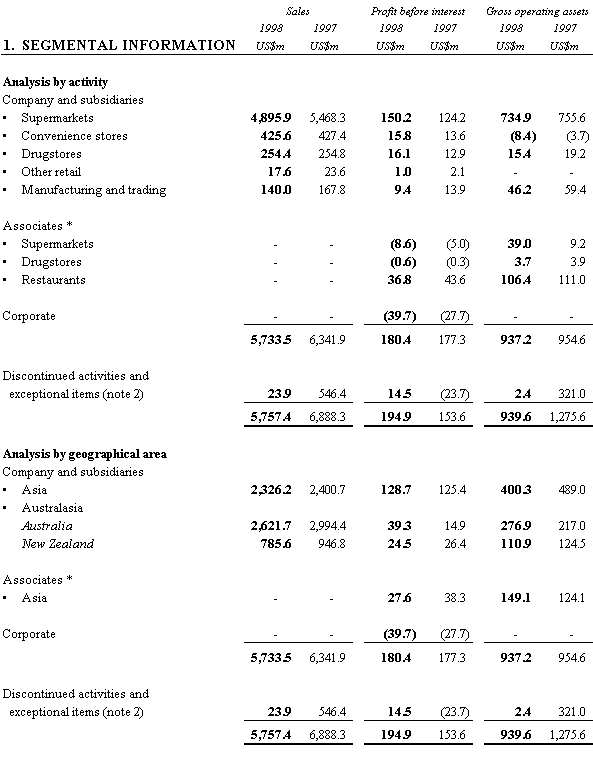
* Associates' results include goodwill amortisation of US$4.7 million (1997: US$1.4 million).
Gross operating assets comprise assets employed in the businesses (excluding deferred taxation assets and bank balances) and after deducting creditors, accruals and provisions.
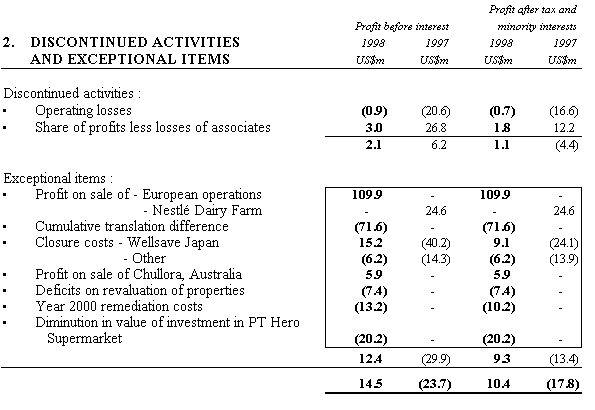
The comparative figures have been restated to include the 1997 operating results of activities disclosed as discontinued in the current year.


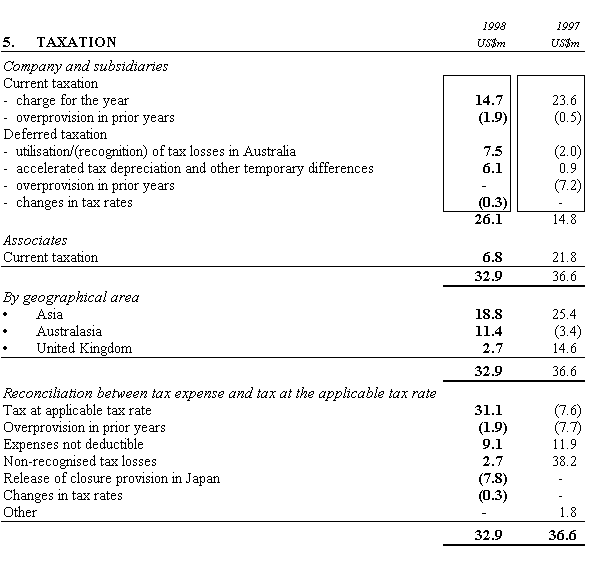
The applicable tax rate represents the weighted average of the rates of taxation prevailing in the territories in which the Group operates.

Ordinary shareholders elected to receive scrip equivalent to a total of US$8.3 million in respect of 1997 interim and final dividends.
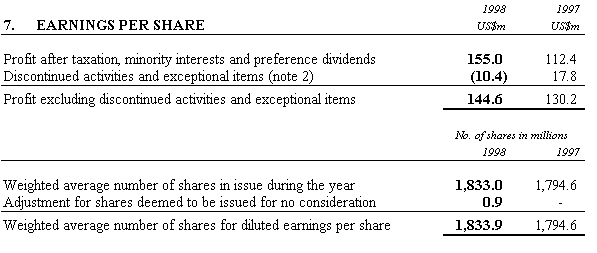
Basic earnings per share are calculated on the profit of US$155.0 million (1997: US$112.4 million) and on the weighted average number of 1,833.0 million ordinary shares (1997: 1,794.6 million).
Diluted earnings per share are calculated on the profit of US$155.0 million and on the weighted average number of shares after adjusting for shares deemed to be issued for no consideration under the Senior Executive Share Incentive Schemes of 1,833.9 million.
The convertible cumulative preference shares were anti-dilutive, and therefore ignored in the calculation of the diluted earnings per share.
Earnings per share excluding discontinued activities and exceptional items are calculated on the adjusted profit of US$144.6 million (1997: US$130.2 million) and on the weighted average number of 1,833.0 million ordinary shares (1997: 1,794.6 million).
Diluted earnings per share excluding discontinued activities and exceptional items are calculated on the adjusted profit of US$144.6 million and on the adjusted weighted average number of shares of 1,833.9 million.

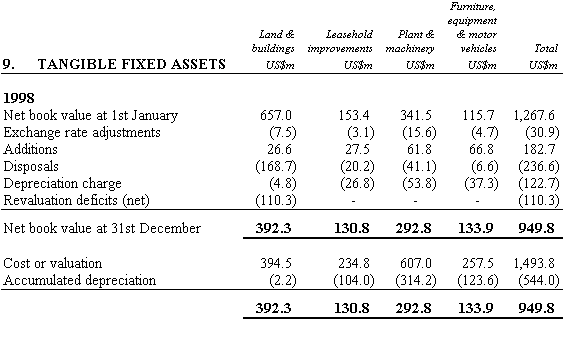
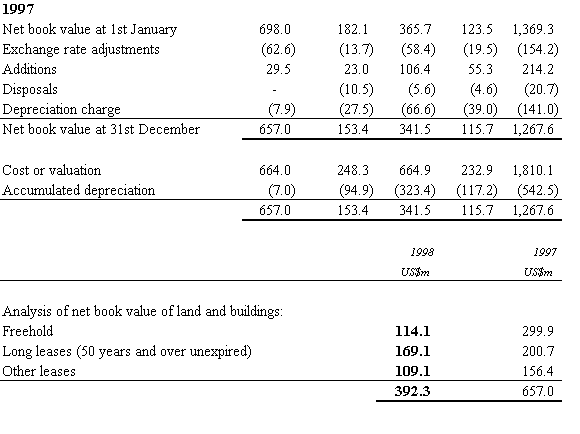
The Group's land and buildings were revalued in December 1996 by independent valuers on an open market for existing use basis. In 1998, the Directors have reviewed these carrying values and deficits on individual properties below depreciated cost of U$7.4 million were charged to the consolidated profit and loss account, while a net deficit of US$102.9 million was taken directly to capital reserves.
If the land and buildings had been included in the Financial Statements at cost less depreciation, the carrying value would have been US$217.2 million (1997: US$359.6 million).
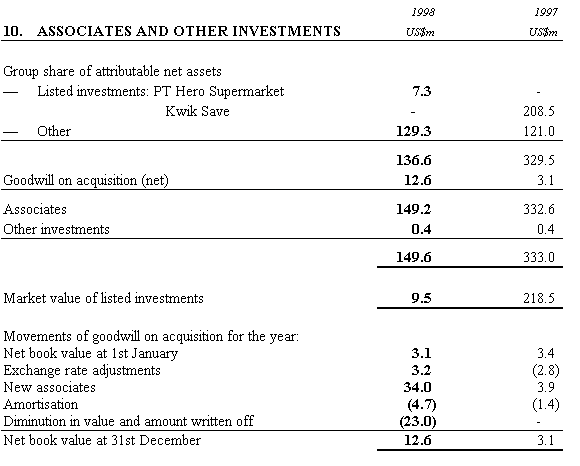
The investment in PT Hero Supermarket is considered to be strategic in nature, accordingly, the goodwill is amortised over 10 years.
The Directors have reviewed the carrying value of the goodwill in PT Hero Supermarket and as a result, reflected a permanent diminution in the carrying value of US$20.2 million.

Deferred taxation of US$7.0 million (1997: US$5.6 million) arising from unused tax losses of US$34.9 million (1997: US$25.6 million) has not been recognised at the end of the year.

At 31st December 1998, the Group held fixed interest rate hedges of US$77.6 million (1997: US$77.6 million) carrying a weighted average rate of 6.1% (1997: 6.1%) for a weighted average period of 1.7 years (1997: 2.7 years).

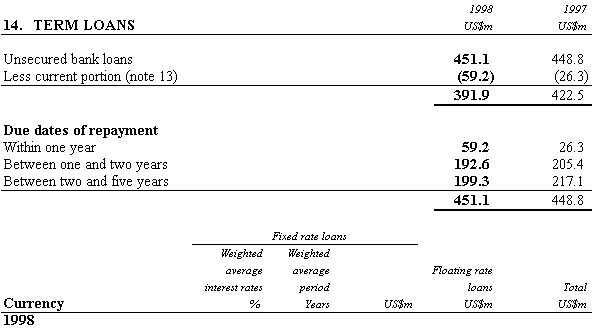
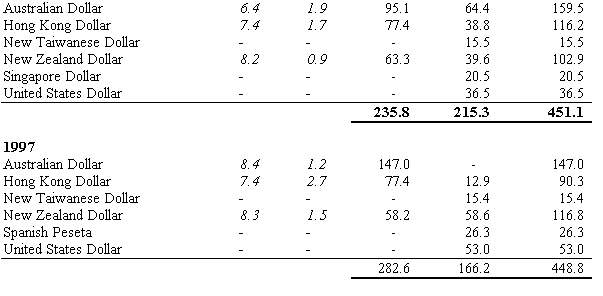
Of the term loans of US$199.3 million due between two and five years, US$126.8 million was originally due to be settled within twelve months of the balance sheet date but has been renewed.
The weighted average interest rates and period of fixed rate loans are stated after taking account of hedging transactions.

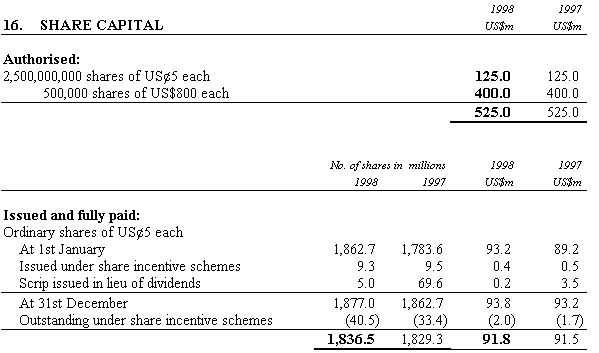
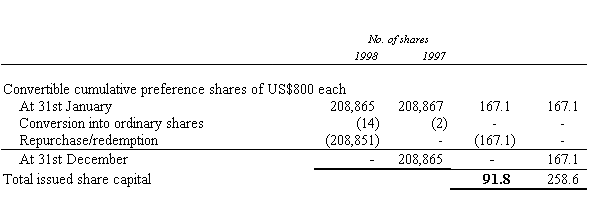
On 2nd July 1998, all outstanding convertible cumulative preference shares were redeemed at US$1,050 per share

The Senior Executive Share Incentive Schemes were set up in order to provide selected executives with options to purchase shares in the Company. Under the Schemes shares are issued to the Trustee of the Schemes, The Verandah Trust Company Limited, a wholly-owned subsidiary, which holds the shares until the options are exercised. Shares are issued at prices based on the average market price for the five trading days immediately preceding the date of grant of the options, which are exercisable for up to 10 years following the date of grant.
As the shares issued under the Schemes are held on trust by a wholly-owned subsidiary, for presentation purposes they are netted off the Companyís share capital in the consolidated balance sheet (note 16) and the premium attached to them is netted off the share premium account (note 18).



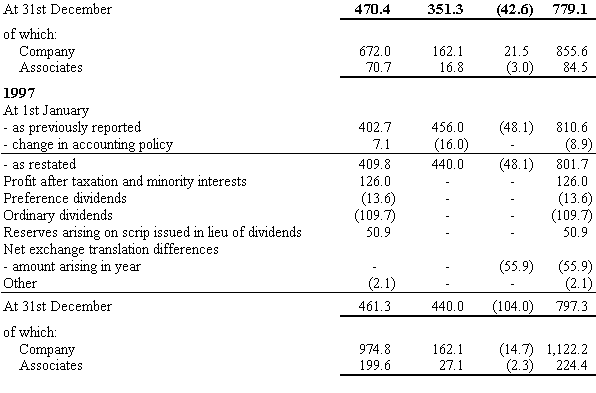
The change in accounting policy related to the introduction of revised International Accounting Standards 12 as detailed in the principal accounting policies.
Capital reserves include property revaluation reserves of US$189.2 million (1997: US$278.1 million).
Property revaluaton deficit during the year comprises US$102.9 million in subsidiaries and US$10.3 million in associates.
Under the Bye-Laws of the Company, the contributed surplus which amounts to US$162.1 million is distributable.
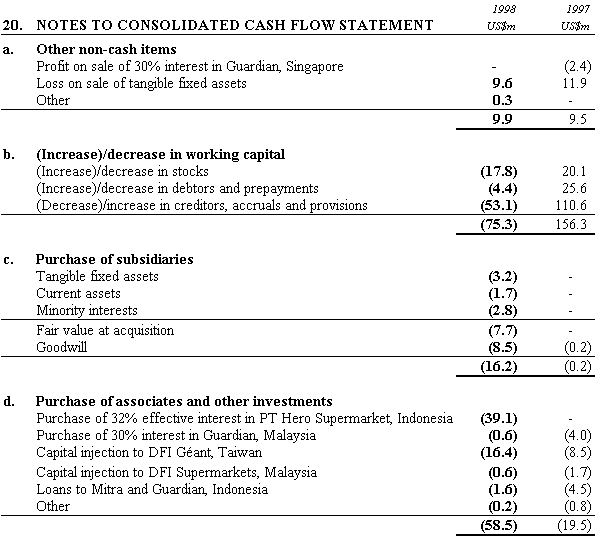
In February 1998, the Group acquired a 32% effective interest in PT Hero Supermarket in Indonesia.
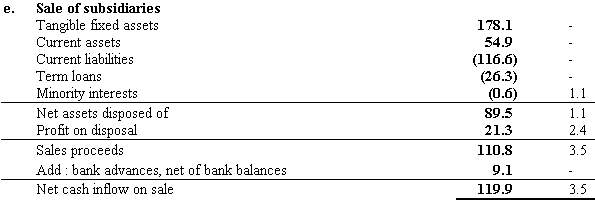
Net cash inflow on sale related to the Group's disposal of its wholly-owned subsidiary, Simago in Spain, to a third party in February 1998.
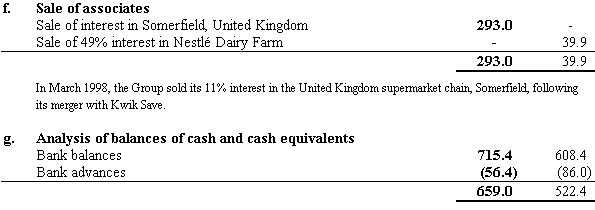

The Group manages its exposure to financial risks using a variety of techniques and instruments. Entering into speculative transactions is specifically prohibited.
Foreign exchange risk
Foreign currency transaction exposures are covered on a consistent basis by forward contracts and options. Foreign exchange contracts are also used to hedge investment in foreign subsidiaries and associates, where the currency concerned is anticipated to be volatile and where the exposure of the Group is material. Consistent with Group policy on covering transaction exposures, the purpose of these hedges is to eliminate the impact of movements in foreign exchange rates on transactions.
Interest rate risk
The Group is exposed to interest rate risk through the impact of rate changes on interest bearing liabilities and assets. These exposures are managed partly by using natural hedges that arise from offsetting interest rate sensitive assets and liabilities, and partly through the use of derivative financial instruments such as interest rate swaps, caps and options.
Funding risk
The Groupís ability to fund its existing and prospective debt requirements is managed by maintaining the availability of adequate committed funding lines from high quality lenders.
Counterparty risk
The Groupís ownership of financial assets involves the risk that counterparties may be unable to meet the terms of their agreements. The Group manages these risks by monitoring credit ratings and limiting the aggregate risk to any individual counterparty.
Fair values
The fair values of the Group's financial assets and liabilities, before taking account of hedging transactions, are summarised as follows :
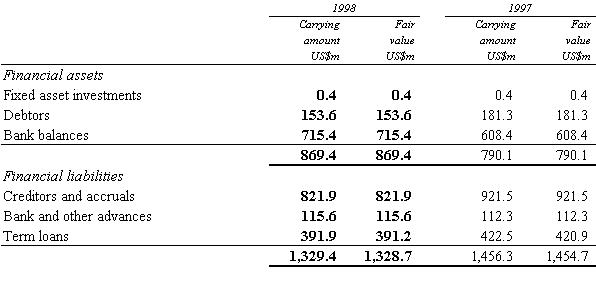
The fair value of debtors, bank balances, creditors and accruals, and bank and other advances approximate their carrying amount due to the short-term maturities of these assets and liabilities. The fair value of term loans is estimated using the expected future payments discounted at market interest rates.
Currency profile
The currency profile of the Group's financial assets and liabilities, before taking account of hedging transactions, is summarised as follows :
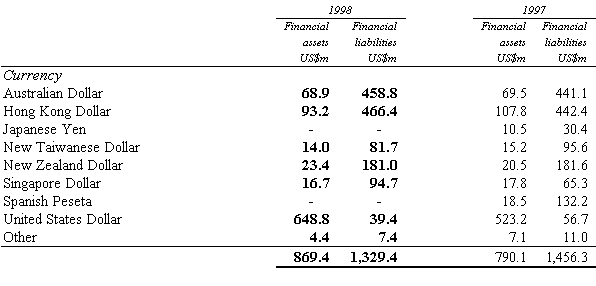
Derivative financial instruments

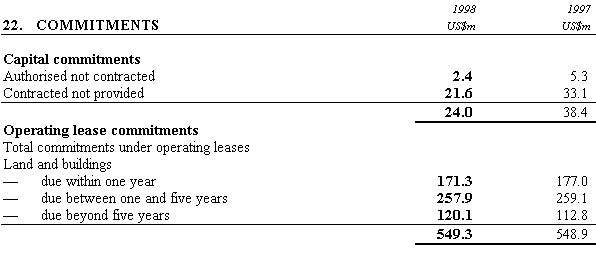
In addition, the Group has operating lease commitments with rentals determined in relation to sales. It is not possible to quantify accurately future rentals payable under such leases.
Pension commitments
The Group has pension commitments in respect of its defined benefit plans, with the major plans relating to employees in Hong Kong.
The Groupís major plans are valued periodically by independent qualified actuaries. The principal assumptions were investment returns at 9% p.a., salary increases at 8% p.a., and discount rate of 9% p.a. on valuing the obligations. The fair value of the assets of the Groupís major defined benefit plans at their latest valuations at 1st January 1999 was US$84.9 million and the actuarial present value of the benefits that had accrued to members after allowing for future salary increases amounted to US$63.3 million.

Various Group companies are involved in litigation arising in the ordinary course of their respective businesses. Having reviewed outstanding claims and taking into account legal advice received, the Directors are of the opinion that adequate provisions have been made in the Financial Statements.
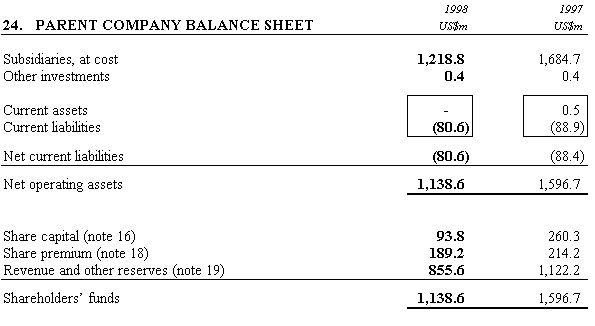

In July, the Group purchased the remaining 25% shareholding in Sims Trading from Jardine Pacific Limited, a wholly-owned subsidiary of Jardine Matheson Holdings Limited, at a cost of US$5.7 million.
In the normal course of business the Group undertakes on an armís length basis a wide variety of transactions with its associates and with Jardine Matheson Holdings Limited and its subsidiary undertakings and associates. All of such transactions are considered to be immaterial in the context of the Group.
In addition, the Group paid a management fee to Jardine Matheson Limited, a wholly-owned subsidiary of Jardine Matheson Holdings Limited, being 0.5% per annum of the Group's net profit after taxation and minority interests in consideration for certain management consultancy services provided by Jardine Matheson Limited.

In January 1999, Dairy Farm completed the sale of 100% of its interest in Oliver's Super Sandwiches to Jardine Pacific Limited, a wholly-owned subsidiary of Jardine Matheson Holdings Limited, for US$5.8 million.

A list of principal subsidiaries and associates is attached.
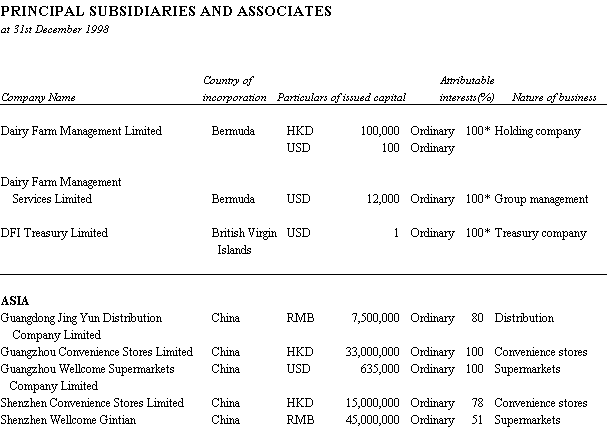
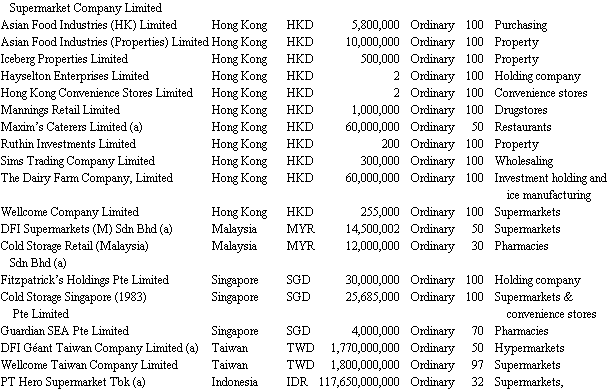
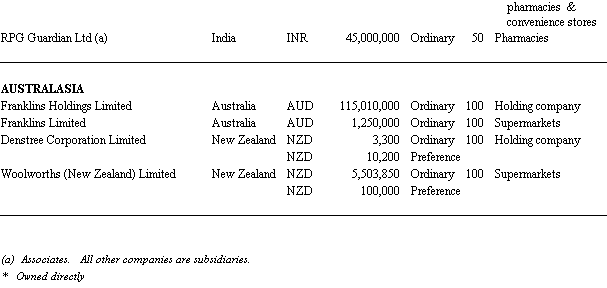
Copyright 1998 Dairy Farm Group / DISCLAIMER. All Rights Reserved